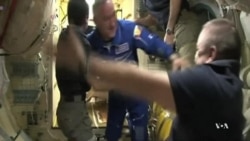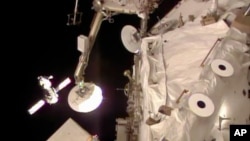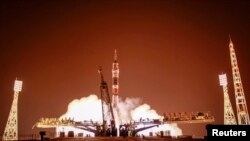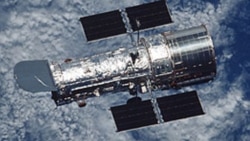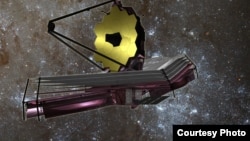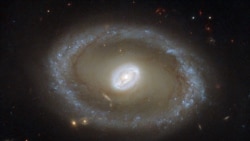From VOA Learning English, this is Science in the News.
I’m Anna Matteo.
And I’m Christopher Cruise.
Today, we report on concerns that tensions over Crimea and Ukraine may hurt cooperation between Russia and the United States in space exploration. Then, we tell about the effect of the Earth’s gravitational pull on the Moon. Finally, we tell about the Hubble Space Telescope and how it has changed the way we look at the universe.
Is US-Russia Space Cooperation in Danger?
The government in Russia says it may take action against the United States to answer sanctions against Russian officials. The sanctions are meant to punish officials involved in the Russian takeover of Crimea. Russian deputy Prime Minister Dmitry Rogozin announced in May that the government may re-examine space cooperation between the two countries. If Russia decides to end its partnership with the United States, the decision could affect future space explorations on the International Space Station.
The United States wants Russia to agree to continue cooperation on the space station until 2024. Russia now says it may end the partnership by 2020. But the largest and most-important joint effort in space does not seem to be threatened.
American astronaut Rick Mastracchio recently returned to earth after spending more than six months in space. He says relations between American and Russian astronauts on the space station are just as good as ever.
“The working relationship that we have at the person-to-person level -- on, both on board the space station, and even here on the ground -- we get along very well with our Russian colleagues, so there’s been no problem whatsoever working with them.”
Scott Pace is the Director of the Space Policy Institute at The George Washington University in Washington, D.C. He says the work and personal relations between the astronauts may not be affected. But he adds that the political environment and the reasons for continuing space cooperation have come under a lot of pressure.
“The question is, is is this a temporary state of affairs or is this a more of a permanent watershed state of affairs which would call into question the entire range of, you know, post-Soviet cooperation that we’ve had with Russia?”
Scott Pace notes that NASA -- the American space agency -- expects to launch the Orion capsule by 2017. The spacecraft will carry astronauts to the space station and even further, without Russian involvement.
Officials know that shrinking public support and reduced budgets for sending human crews to deep space means that international cooperation is necessary.
NASA Administrator Charles Bolden, Jr. spoke at the Berlin Air and Space Show earlier this year about the future of space exploration. He said NASA understands the importance of cooperation.
“And I have to emphasize, there’s nothing on this chart that we’re doing alone.”
For example, the power systems for the Orion capsule are made by European engineers. Much of the spacecraft is being built in Germany.
But Russian space officials did not take part in the discussions about Orion. Scott Pace says Russia wants to explore the Moon, but may not have the money to do it.
“Russia is gonna have to make a decision as to what it wants to really be doing in space past 2020.”
In May, a Russian Soyuz rocket carried three astronauts to the International Space Station. The three are American astronaut Reid Wiseman, Russian cosmonaut Max Surayev and German Alexander Gerst of the European Space Agency. They arrived at the space station six hours after launch from the Baikonur cosmodrome in Kazakhstan.
The three will remain in earth orbit for six months.
NASA depends on the Russian spacecraft to fly crews to and from the space station.
Scientists See Effect of Earth’s Gravitational Pull on the Moon
The gravity of the Moon is responsible for the rise and fall of our planet’s ocean tides. But researchers have found that the Earth has a similar effect on the Moon.
NASA scientists say they have been able to see what they call a “bulge” in the Moon caused by Earth’s gravitational pull.
Erwan Mazarico is a scientist with the Massachusetts Institute of Technology in Cambridge, Massachusetts. He also works at NASA’s Goddard Space Flight Center in Maryland.
In a statement, he said “the deformation of the Moon due to Earth’s pull is very challenging to measure, but learning more about it gives us clues about the interior of the moon.”
NASA scientists say the gravitational effects on both the Earth and moon are very powerful. In their words, the effects are strong enough to stretch them enough “so they wind up shaped a little like two eggs with their ends pointing toward one another.”
We can observe the Moon’s effect on Earth by watching ocean tides rise and fall. But the effect on the Moon is more difficult to see. That is because, except for a small core -- or center -- the Moon is solid. And only one side of the Moon can be seen from Earth.
Yet scientists say the Earth’s gravity is strong enough to create a 51-centimeter high bulge on both the near and far sides of the moon. NASA officials say the lunar bulge “shifts a few inches over time” as the Earth moves, “like a dance partner, following wherever the lead goes.”
NASA scientists used information from the Lunar Reconnaissance Orbiter, which has been studying the moon since 2009. They also used information from the Gravity Recovery and Interior Laboratory. That let them see the whole Moon, not just the one side that always can be seen from Earth.
Researchers used an instrument on the orbiter to measure 350,000 places on the Moon’s surface. They then compared these measurements to changes in altitude over time to see how the bulge had moved.
The study was published in the journal Geophysical Research Letters.
Twenty-four Years of Space Images from Hubble Telescope
The Hubble Space Telescope has changed the way we see the universe. For more than 20 years, the telescope has sent large amounts of information and pictures from space. A new exhibit shows much of Hubble’s success comes from the ability of space scientists and astronauts to repair and service it in orbit. The show can be seen at the Smithsonian Institution’s National Air and Space Museum in Washington, D.C.
The Space Shuttle Discovery carried the Hubble Space Telescope into space in April 1990. Soon after the telescope was deployed, it began to send pictures, but they were not clear. Hubble Space Telescope Program Manager Douglas Broome reported the bad news.
“The conclusion we’ve come to from that is that there’s a significant spherical aberration appears to be present in the optics, in the optical telescope system optics.”
This meant part of the telescope’s most important mirror was too flat, by about 1/50th the thickness of a human hair. In 1993, a space shuttle crew brought a replacement camera, called WFPC2. It also had an instrument with corrected lenses -- called COSTAR -- for astronauts to place on the telescope.
“The COSTAR inserted mirrors into the optical beam that corrected the light for all the other instruments.”
David Devorkin is with the National Air and Space Museum. He says the repair work was very difficult. But it was successful, and showed that shuttle astronauts could complete difficult projects in space.
“The whole idea of living and working in space is doing useful stuff --and this certainly was useful. On the astronomical side -- and you might say on the technical side -- it represents how fast telescopes are improving because Hubble was only repaired once, but it was upgraded four times.”
COSTAR and WFPC2 were replaced in 2009. They can now be seen at the museum.
Pictures from Hubble have become clearer over time. Information from the telescope has enabled astronomers to look back 14 billion years -- to the beginning of the universe. And they can see that the universe is growing. David Devorkin says the telescope led to many other important discoveries.
“…understanding star-forming regions, how stars form out of gas and dust, and now the ability of the Hubble to see deeply into the infrared -- far deeper than before -- has shown us the processes inside these interstellar clouds that literally are forming the stars and their interaction with the dust and gas around them.”
Hubble is coming to the end of its life. The James Webb Space Telescope is expected to be launched in 2018. It will have a mirror five times larger than Hubble’s.
“The James Webb is optimized for infrared because all of the most amazing discoveries about galaxy formation, star formation and the kinds of stuff that astronomers want to know is in the infrared.”
Until the James Webb Telescope is operational, Hubble continues to work hard and take pictures that surprise and interest scientists and others.
This Science in the News was written and produced by Christopher Cruise. It was based on stories from the VOA News Division and VOA reporters George Putic and Rosanne Skirble.
I’m Anna Matteo.
And I’m Christopher Cruise.
Join us again next week for more news about science on the Voice of America.



